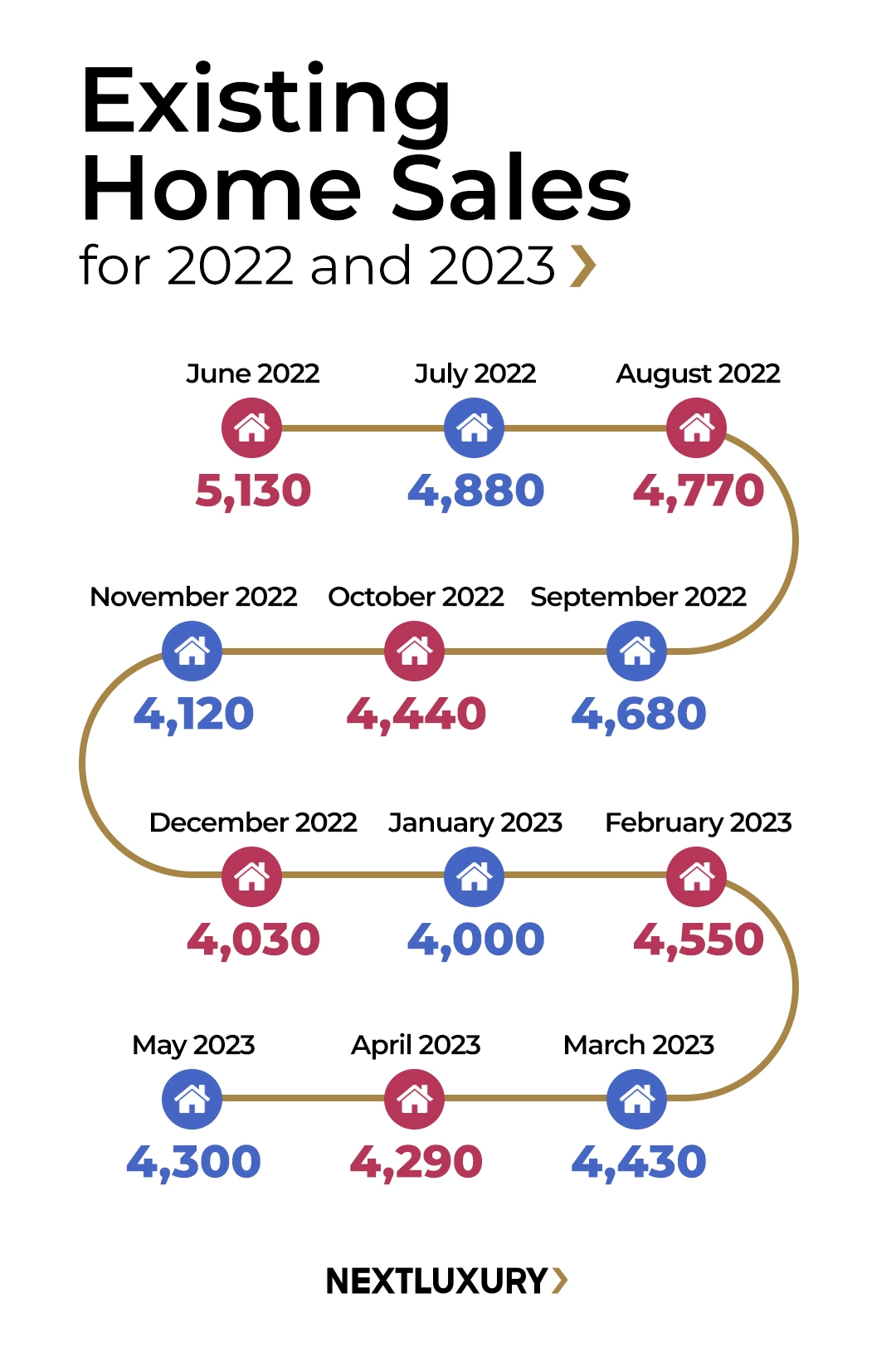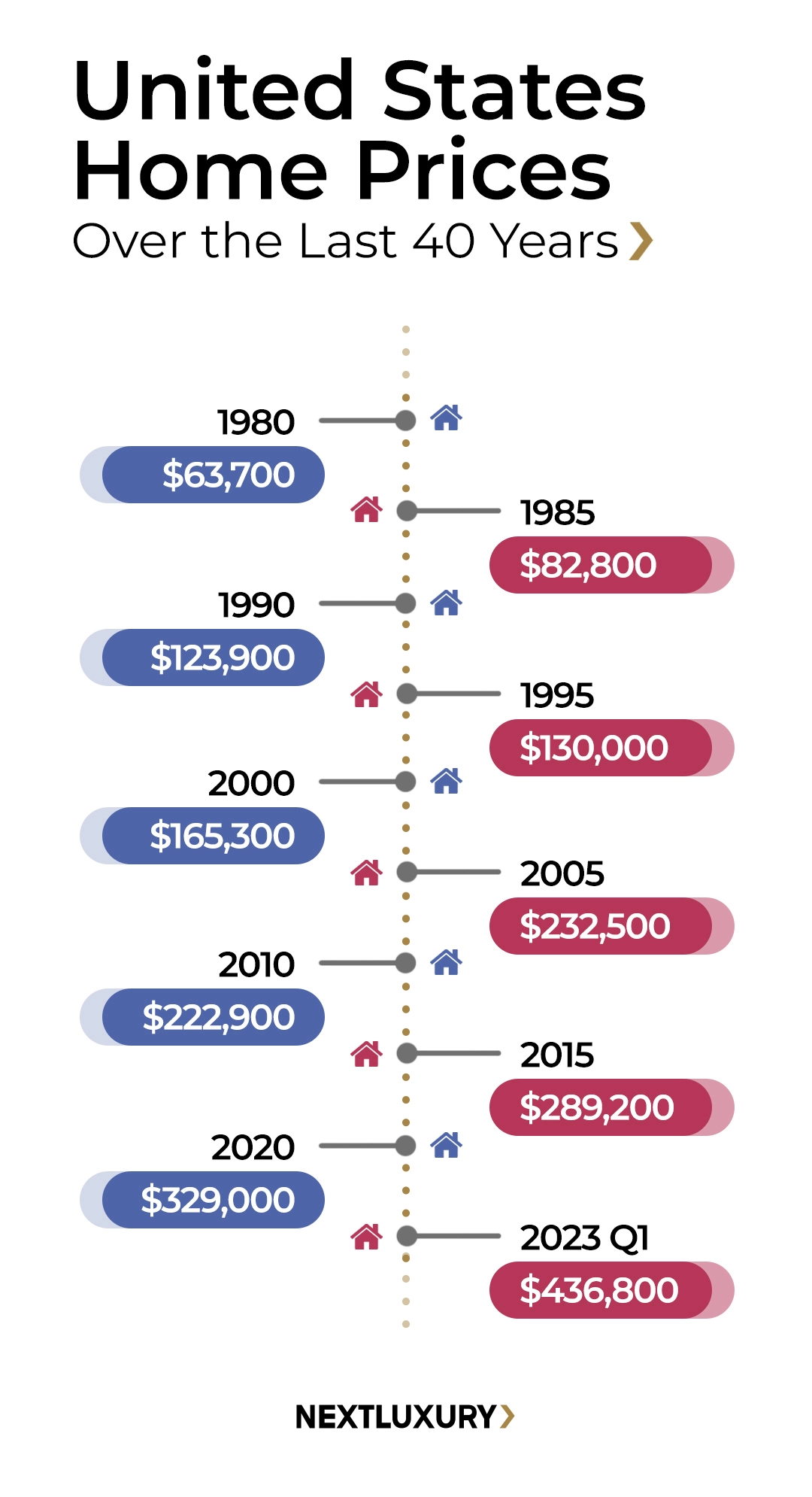
Real Estate Market Predictions and Forecast
The best way to describe current economic conditions in the United States is “uncertain,” and the real estate market can be described in much the same way. What will happen in the real estate market during the rest of 2023 and beyond is unknown at this point, but experts have predictions based on what’s occurred during the year so far and on historical insights and data.
Here, we’ll discuss some statistics and predictions about the state of the real estate market and what may be coming in the near future.
Current State of the Real Estate Market
The real estate market boomed during the pandemic and beyond, with median home prices rising nearly 50% from the second quarter of 2020 to the fourth quarter of 2022. Record low interest rates brought out the buyers, making the market a boon for real estate sellers who could command a higher price from buyers who were competing for available homes. This was the driving factor causing record-high home prices, which at the peak were at a median price of $479,500.
But with inflation rising as well as the fears of a recession, the Fed began raising rates in March of 2022, forcing up mortgage rates. Several rate increases have occurred since, driving many buyers out of the real estate market.
Here is a timeline of the Fed rate increases in 2022 and 2023.

While on the surface, it would seem that this would cause a drastic decrease in home prices, the impact has been nominal because the inventory of available homes is also down. This means that active buyers, although their numbers are down, are still competing for available homes.
Due to those combined factors, as of the first quarter of 2023, median home prices were only down 9% from their peak in the fourth quarter of 2022. This is in spite of the fact that the number of existing home sales is down 23% from the same time in 2022.
To put things in perspective, here is what median existing home prices have done for the last five years.

But take a look at the pattern of the number of existing home sales for 2022 and 2023.

So the number of home sales was declining in 2022 as rates went up, but home prices continued to climb at an unprecedented rate. Even in the first quarter of 2023, when prices are starting to show the effects of the slower real estate market, prices have not decreased in a historically significant way.
To keep things in even more perspective, though, and to illustrate that short-term real estate price fluctuations are just that – short-term – this graphic shows the median average home price over the last 40 years.

So, in spite of fluctuations that occur within those five-year increments, home prices continue to climb in the long term. This is great news and means that real estate is generally a good long-term investment in spite of volatility in the market.
Factors Influencing Real Estate Sales for the Rest of 2023
Interest rates will be one of the largest factors impacting real estate sales for the rest of the year. What happens to interest rates will depend on inflation and the overall course of the economy. Consumer expectations and fears will also be a factor. Many people are worried that the country will slump into a recession, making them less likely to make large purchases like a home.
The inventory of homes is also low, which keeps the market slow. It’s predicted that inventory will remain low due to 91% of homeowners who are sitting on a mortgage with a rate below 6%, making them unlikely to sell.
The combination of interest rates, inventory levels, and economic conditions and expectations will drive the behavior of buyers and sellers, and thus the number of home sales and the direction of home prices.
Predictions for 2023
Many economists are predicting a return to normalcy in the 2023 real estate market, meaning an end to the booming sales and record price increases of the last few years. Mortgage rates are higher than they were a year ago, which will likely keep the market slow, but most predict that rates will at least stabilize, potentially halting further declines in sales volumes.
NAR chief economist Lawrence Yun expects housing inventory to remain tight in 2023, with fewer homeowners selling. This is evidenced by an existing home inventory that is 46% lower than its historical average. This is likely to keep home prices from declining, but price appreciation will likely slow considerably.
However, those who are selling may start to feel added pressure due to a limited number of buyers. This may give buyers the leverage to be able to negotiate a lower price, which can somewhat offset the impact of higher mortgage rates. Discerning buyers may thus be able to find opportunities in this year’s market from an investment perspective.
But the fact that home prices are still high after the unprecedented increases in the last few years is keeping many home buyers out of the market. High home prices are a double-edged sword –they’re great for homeowners, but create a lack of affordable housing for home buyers, especially first time buyers.
Experts estimate that anyone making under $75,000 per year will not be able to buy a home at current price levels. A $75,000 income can generally qualify a buyer for a $256,000 home, but homes at or under that price only account for 23% of the total number of existing homes. And unfortunately, over half of American households earn less than $75,000.
This data explains why in 2023, the largest group of home buyers – 39% – are Baby Boomers, instead of Millennials who have long been buying the biggest share of homes. Baby Boomers generally make more income than younger groups, and thus are not priced out of the market. The number of first-time home buyers is also down 8% in 2023 compared to 2022, undoubtedly due to the lack of affordable housing.
The fact is, however, that uncertainty still exists for the rest of 2023. While it’s almost a certainty that rates will not decline significantly, whether they will stabilize or continue to rise is unknown. The overall state of the economy is also difficult to predict, which increases real estate uncertainty. Most economists, however, are predicting that a recession will occur sometime in 2023, which will keep pressure on the real estate market.
However, experts do not predict massive home price declines. They cite a possible additional 5% decrease in 2024, which may only amount to a 10% total decrease from the unprecedented peak prices in 2022. And from 2025 to 2027, they say it’s likely that home prices will again start to increase at a rate of 1% to 2% over the inflation rate. The number of existing home sales is also projected to increase and reach a level of 22% over 2022 numbers by 2027.
Regional Differences
Of course, real estate markets across the country do not necessarily see the same impacts. In areas that saw the largest price increases over the last few years, home price declines are likely to be larger in 2023. This is true of many West Coast cities, and places like Phoenix and Austin. In Austin, for example, prices have dropped by more than 17% from their peak, while prices in the Bay Area of California are down about 30%.
However, in areas with high job growth and already affordable housing prices, the real estate market is likely to stabilize, and prices in those areas may even increase. This may be the case in many parts of the Midwest and the Northeast.
Home Prices by State
To show the difference between markets across the country, let’s look at median home prices by state in the 4th quarter of 2022.
The states with the highest median home prices were:
● Hawaii – $959,134
● District of Columbia $803,327
● California – $763,358
● Washington – $527, 158
● Massachusetts – $569,951
The states with the lowest median home prices are:
● West Virginia – $126,891
● Mississippi – $155,020
● Arkansas – $166,626
● Oklahoma $169,307
● Iowa $183,159
That’s a huge gap from high to low, and changes in the overall economy and interest rates affect different markets in different ways.
The fact is, though, that real estate markets often operate on a more micro level. For example, the city with the highest median sales price is San Francisco at $1.36 million, followed by New York City at $950,000. The city with the lowest median home price is Detroit at $59,000.
Prospective home buyers and sellers need to stay informed about market conditions specific to their city or town before making decisions.
The NAR has identified 10 markets that should show a strong real estate market in 2023.

This is based on factors such as housing affordability and increasing inventory, and it illustrates how micro real estate markets are. Prospective home buyers and sellers need to stay informed about market conditions specific to their city or town before making decisions.
Could the Housing Market Crash?
Some consumers are concerned that the real estate market may experience a crash similar to the crash of 2008. They cite the record price increases that have occurred in the last few years and see that as a “bubble” similar to the one that occurred in 2008. The facts are, however, that several factors, including predatory lending practices and a lack of regulation, led to the crash of 2008, and those factors are not in play in the current market.
What’s happened in recent years was that the real estate market boomed due to the low-interest rates that occurred as the Fed tried to stimulate the economy during the pandemic. Now, rates have risen as the Fed tried to rein in inflation, which in reality has just “checked” the real estate market to return it to normalcy.
Essentially, the likelihood of a housing market crash in the current environment is extremely low. In 2008, housing prices declined by about 30%, which is typical of a housing market crash, but that level of decline has not occurred nor does anything indicate that it will occur.
Conclusion
The bottom line is that what occurred in the real estate market in the last few years was a bit of an anomaly, and what is likely to occur in 2023 is a return to normalcy. To put things in perspective, over the last 50 years, the average mortgage rate was about 8%, and current rates are still below that number. It’s a matter of relative perception that’s slowing the demand for homes. People see that a year ago, interest rates were about half of what they are now, when in historical reality, those low rates were an anomaly, and the rates now are closer to normal.
The real estate market may be a bit rocky for the rest of 2023, but it’s nothing to be concerned about in the big picture. Markets go through ups and downs, and “this too shall pass.”
